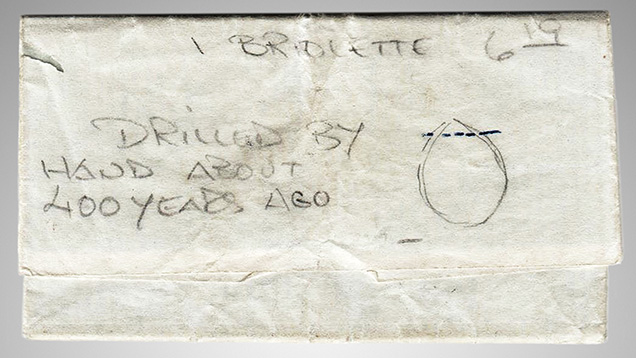Hole Drilled by Hand in Briolette



However, Tavernier’s gems are not the earliest recorded briolettes. One had arrived in the royal court in England almost 20 years before his first voyage to India. On February 17, 1612, payment was arranged to the Flemish goldsmith Stephen le Gouche for a piece of jewelry with “one fair large pendant diamond, cut with fancies [facets] on all sides, and pierced at the top” that had been delivered to Queen Anne of Denmark (Green, 1858, p. 121), who was married to James VI and I (r. 1603–1625). The court accounts further describe the piercing at the top as lateral.
Noël-Antoine Pluche’s extensive multivolume work on natural history, Le Spectacle de la Nature, features an illustrated briolette described as a pear-shaped diamond cut in the “taille à l’Indienne” or Indian style (1748, pp. 349–352). The comments by Pluche, along with the Indian examples traded by Tavernier, point to the briolette form as being associated with India. Several later books specifically state this association and even mention lateral piercing. A French encyclopedia from 1859 (Guillaumin, pp. 980–981) explains that “In India, where the briolettes formerly came from, it was customary to pierce them with a very small hole in the upper part. Today a few lapidaries in Amsterdam cut briolettes very well, but they haven’t yet managed to pierce them.”
By 1600, Italian, German, Flemish, and Belgian cutters worked in India (Everaert, 2000, 2005), bringing along their techniques and cutting styles to higher-quality rough. These faceted stones would then be sent to Europe (Ogden, 2018, pp. 297–305). For example, the briolette shown in Tavernier’s book may have been cut by a European living in India rather than by a local Indian diamond cutter (there is no mention of a hole in the briolettes sold by Tavernier). Indian diamond cutters continued to follow their own styles, often cutting the lesser-quality rough destined for the Indian market. Short of documentation showing early briolettes with this specific facet arrangement by Indian cutters, dating the 6.19 ct briolette from Mr. Frank is impossible.

In 1811, Napoleon Bonaparte presented a 263 ct diamond briolette necklace to his empress consort, Marie Louise. It featured 19 oval- and pear-shaped briolette-cut diamonds (probably of Indian origin but faceted by European cutters in India) with drill holes. The facet arrangements of the stones in the necklace are more symmetrical and quite different from the 6.19 ct briolette.
It is unclear when laser drilling for larger holes began, but General Electric researchers used a laser to drill 0.02-inch-diameter holes into an industrial diamond in the early 1960s (Overton, 2008, p. 46). As early as 1970, GIA’s Robert Crowningshield reported that lasers were being used as part of a process to bleach or dissolve dark inclusions, and soon this treatment was widely available to members of the trade (Overton, 2008, p. 46). This means that sometime after the 1970s, lasers would have been employed for the process of drilling holes for beads and such. Older briolettes that came into GIA’s laboratory would still have holes drilled by hand, but by the 1980s, this hand drilling process was mostly abandoned. Has GIA seen a handmade drill hole in diamonds in the past, and if so, how many? Uncovering records of hand-drilled diamonds submitted to the laboratory is quite difficult since records prior to the 1990s are not computerized for searching and briolettes are rarely seen. Notations about the surface of the drill hole are also uncommon in reports. Our research into past submissions did not yield any useful results.
From the above, it is impossible to date this diamond, although it was probably cut before 1920 in India, possibly much earlier, but not by highly skilled cutters.
The briolette is heavily abraded. One possible reason is that it was kept in a diamond parcel rubbing against other diamonds for a long time, though this seems unlikely. Why would any diamond merchant allow a diamond in their stock to become so excessively abraded? It was more likely worn in an item of jewelry, repeatedly wearing against other diamonds and being casually stored by the owner, suggesting an extended period of use.
Of final note, there are several naturals on the surface of the briolette, including a trigon (figure 5).

.jpg)


